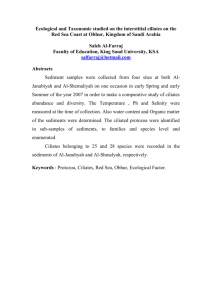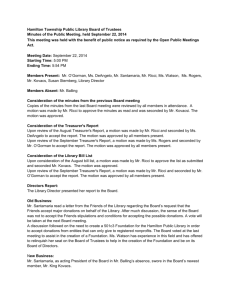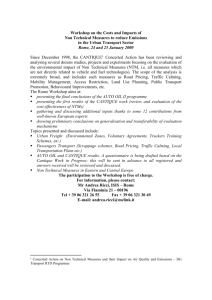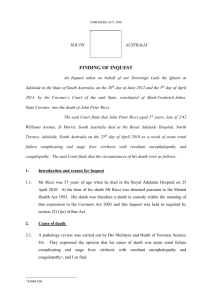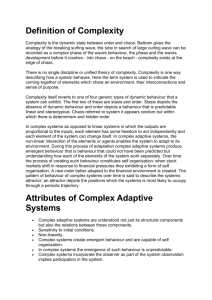Protistology The ethology of Protozoa and the “adaptive space
advertisement
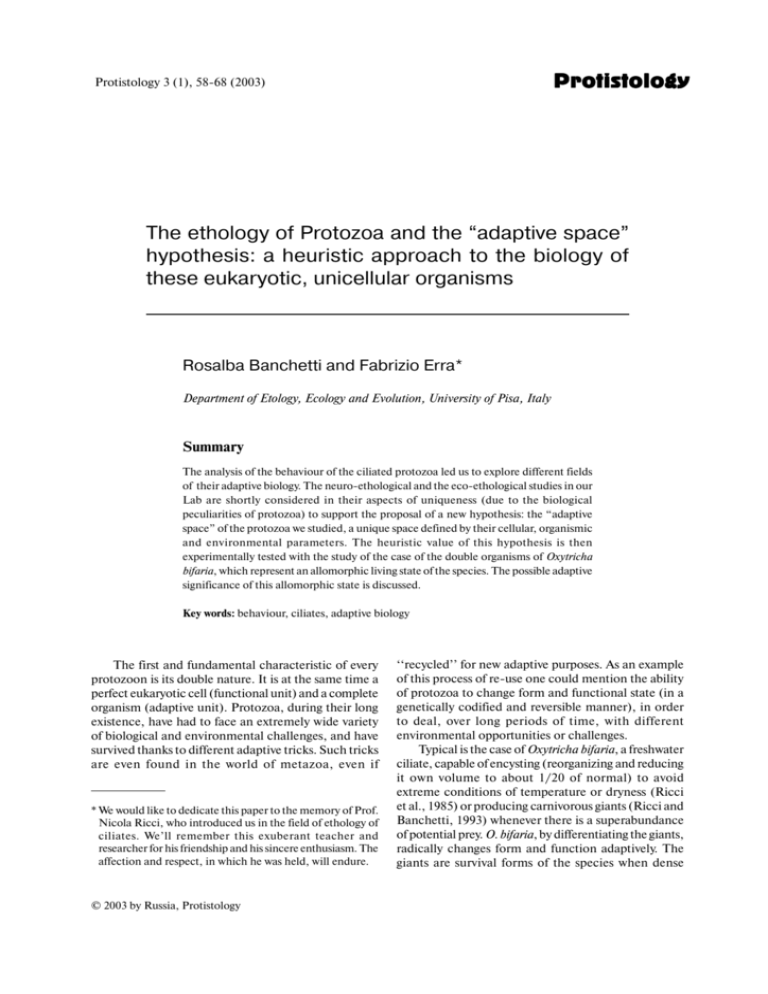
Protistology Protistology 3 (1), 5868 (2003) The ethology of Protozoa and the “adaptive space” hypothesis: a heuristic approach to the biology of these eukaryotic, unicellular organisms Rosalba Banchetti and Fabrizio Erra* Department of Etology, Ecology and Evolution, University of Pisa, Italy Summary The analysis of the behaviour of the ciliated protozoa led us to explore different fields of their adaptive biology. The neuroethological and the ecoethological studies in our Lab are shortly considered in their aspects of uniqueness (due to the biological peculiarities of protozoa) to support the proposal of a new hypothesis: the “adaptive space” of the protozoa we studied, a unique space defined by their cellular, organismic and environmental parameters. The heuristic value of this hypothesis is then experimentally tested with the study of the case of the double organisms of Oxytricha bifaria, which represent an allomorphic living state of the species. The possible adaptive significance of this allomorphic state is discussed. Key words: behaviour, ciliates, adaptive biology The first and fundamental characteristic of every protozoon is its double nature. It is at the same time a perfect eukaryotic cell (functional unit) and a complete organism (adaptive unit). Protozoa, during their long existence, have had to face an extremely wide variety of biological and environmental challenges, and have survived thanks to different adaptive tricks. Such tricks are even found in the world of metazoa, even if * We would like to dedicate this paper to the memory of Prof. Nicola Ricci, who introduced us in the field of ethology of ciliates. We’ll remember this exuberant teacher and researcher for his friendship and his sincere enthusiasm. The affection and respect, in which he was held, will endure. © 2003 by Russia, Protistology ‘‘recycled’’ for new adaptive purposes. As an example of this process of reuse one could mention the ability of protozoa to change form and functional state (in a genetically codified and reversible manner), in order to deal, over long periods of time, with different environmental opportunities or challenges. Typical is the case of Oxytricha bifaria, a freshwater ciliate, capable of encysting (reorganizing and reducing it own volume to about 1/20 of normal) to avoid extreme conditions of temperature or dryness (Ricci et al., 1985) or producing carnivorous giants (Ricci and Banchetti, 1993) whenever there is a superabundance of potential prey. O. bifaria, by differentiating the giants, radically changes form and function adaptively. The giants are survival forms of the species when dense Protistology · populations undergo severe starvation. They are carnivorous predators, namely differentiated states of the species feeding on new pabula (ciliates instead of bacteria). In this way they reduce the intraspecific competition for the normal bacterial food and from primary consumers become secondary consumers. The successive steps of the giant formation in O. bifaria are successive phases of a primigenial cell differentiation, that is a reversible phenomenon. This potential tool was the first realization of what metazoa recycled later as irreversible cell differentiation. Irreversibility was added only when multicellularity was reached (Ricci and Banchetti, 1993). The second characteristic is that protozoa are ‘‘small’’, the average dimensions varying from 30 to 300 µm. This simple ‘‘being small’’ has consequences for their biology. (A) As discussed by Purcell (1977), organisms of these dimensions live at low Reynolds numbers, namely they experience a peculiar aqueous environment, where, no inertia conditioning their locomotion, the viscoelastic forces mainly affect it (we will discuss in another paragraph the consequences of this property of protozoa). (B) All of the environments are fragmented for them into a myriad of environmental micropatches, identified by the infinite combinations of the minimum variations in space and time of the various environmental parameters, which support the local biodiversity of protozoa. (C) Whenever there are optimal physiological states and favorable external conditions, they multiply at extremely high repro ductive rates in soils, rivers and seas (Finlay et al., 1988; Finlay, 1990). (D) Protozoa, the first eukaryotes to reach the niches of primary and secondary consumer (Gould et al., 1977) achieved the first ‘‘complete ecology’’. These organisms are the successive steps of the microbial food chain, that is the “microbial loop”. They are large enough to be proper food for both larvae and adults of larger metazoa that belong to the “macrobial loop” (Azam et al., 1983; Fenchel, 1987). From Jennings (1906), the first modern scientist to study the ‘‘behaviour of lower organisms’’ with a naturalistic, experimental mentality, the behaviour of ciliated protozoa has been increasingly seen as an object of study of great importance for anyone interested in discovering new pieces of the great jigsaw puzzle of nature (Ricci, 1981; Ricci et al., 1995; Leonildi et al., 1998). A short preface shoul be given to review the basic elements of an ethogram: all the species studied by us creep on the substrate along a piecewise linear path formed by three Long Lasting Elements, LLE (they last one to several seconds: rightward arcs, A +, segments, S, and leftward arcs, A) and four Short Lasting Elements, SLE (they last about 1/10s: 59 Continuous Trajectory Change, CTC, Smooth Trajectory Change, STC, Rough Trajectory Change, RTC, and Side Stepping Reaction, SSR), which mediate the passage from one LLE to the next. Here we would like to put forward the study of the ethology of protozoa as a precious instrument: we will discuss what such a study can contribute to our knowledge of protozoa.. 1. THE NEUROETHOLOGICAL APPROACH In protozoa the nature of perfect eukaryotic cell and complete organism coincide: this makes them a convenient material for neuroethological investi gations, namely for the study of the relationships between behavioural patterns and electrical activities underlying them (Hoyle, 1970; Usherwood and Newth, 1975; Ewert, 1976; Kandel, 1976). The very character of neuroethology leads it to concern with the analysis of the relations between the manifold organizational levels that have to interact for the expression of behaviour: from the cellular organelle (for example: the cell membrane), to the cell (for example: the neuron), to the tissue (for example: the neural network), to the organ (for example: the ganglion), to the system (for example: the nervous system), and finally to the phenomenon that integrates and expresses all this, namely the behaviour. Huber and Markl (1983) and Cliff (1991) stated that a neuroethological approach iwill be all the more precious the greater is the distance between the interacting levels analyzed. The use of ciliates in neuroethology was proposed (Ricci, 1992) on the basis of three facts: a) the electrophysiology of ciliates is a very wellknown field of protozoology (Machemer and Teunis, 1996); b) the behaviour is well studied and understood (Ricci, 1989, 1990); c) the double nature of cell and organism that characterizes protozoa makes possible the direct study of the electrophysiology of a single cell (the lowest neuro ethological level) and its corresponding behavioural states (the highest neuroethological level). Direct attribution of behaviour of freely moving organisms to spontaneously occurring electrical events has already been described in Bursaridium difficile (Berg and Sand, 1994). In our laboratory an attempt was made to find in Euplotes vannus spontaneous beha vioural patterns and then identify their electrical equivalents by means of a computerized videotrack analyzing system to correlate beating of cirri to the membrane potential of a freely walking organism (Lueken et al., 1996). It was demonstrated that the creeping velocity of organisms varies spontaneously and periodically (SlowandFast pattern) in quite a regular manner (T≈0.60.8s) (Fig. 1A,B); the relative memb 60 · Rosalba Banchetti and Fabrizio Erra its manifold cellular or orga nismic meanings by means of neuroethology. 2. THE ECOETHOLOGICAL APPROACH The ecoethological app roach to protozoa may, so to say, “putt us in their shoes”, and lead us to a better understadning of their peculiar environment and equally peculiar environmental biology. Fenchel’s book (1987) had marked the beginning of a real ecology of protozoa, to throw light on the numerous pecu liarities and the importance for Fig. 1. (A) A tracktype of Euplotes vannus is shown as the succession of the positions of the baricentre of the organism in the succession of single photograms the flow of energy and substance of the videorecording; (B) the variation in time of the velocity of the organism that these organisms mediate in from point to point; (C) an analogous pattern of the membrane potential of any environment. The simul this ciliate, spontaneously recurrent in the absence of stimuli. taneous development of etholo gical studies of protozoa, demon rane potential in the same conditions oscillated in a strating the close link between some of their adaptive similar way (T≈0.7s) (Fig.1C). This observation seems characteristics and environmental peculiarities, to suggest that spontaneous bursts of depolarizations indicated that the ecoethological approach was also are responsible for the slowandfast rhythm in freely possible for these organisms (Fig. 2) (Ricci, 1992a, walking cells, by affecting beating of the cirri so that 1996). This first ecoethological research enabled us to cells decelerate during the depolarizing level, accelerate during the repolarization, and reach full speed during discover a vast microhabitat ideal for the settlement of the common potential level (2530 mV): this hypotrich ciliates: the bacterized WaterAirInterface, WAI (Ricci et al., 1991). The behavioural analysis led represents the system of control of the velocity. The correspondence in frequencies of the slow us to study the movements of O. bifaria in contact with andfast rhythm in walking cells (1.3/s) and of the the WAI: if it is free from bacteria, O. bifaria tends to depolarization pattern of the membrane potential avoid the WAI, and, if moving on it, never performs (1.4/s) was confirmed in the wide majority (80%) of any trajectory change but the Continuous Trajectory track recordings. Whenever the membrane potential Change. Furthermore, O. bifaria moves by sliding and assumed values ≥ 15 mV, the beat of both fronto drifting obliquely along rightward arcs (A+), with short ventral and transverse cirri is inverted: this value seems radii (≈250 µm vs. 890 µm of controls), wide central to be a threshold controlling the execution of a Side angles (β≈140 o vs. 50o of controls), and centers in Stepping Reaction (SSR). In SSR deceleration ends slightly different positions with respect to each other in a complete stoppage that is succeeded by backward (Fig. 3, upper left part). This slow (v≈220 µm/s vs. 550 jerking. In recordings of the freerunning membrane µm/s of controls), constant and monotonous loco potential, SSRs correspond to longlasting depo motion seems to suggest that colonization of the WAI larizations. Resumption of forward running is the is brought about by this species mainly according a bidimensional dispersion mediated by the creeping consequence of repolarization. To different states of the membrane potential of itself, rather than by the swimming. On the contrary, whenever the interface is the ciliate correspond different states of functioning of the motor organelles that determine different behaviour colonized by a bacterial film, the population settles in patterns. These results demonstrate that “complex it leaving the free interface immediately. O. bifaria behaviours have their roots in the principles of sensory moves (Fig. 4, upper right part) on the substrate at ≈550 motor coupling” (Machemer and Teunis, 1996) and µm/s, along normal tracks formed by a succession of that in protozoa each phenomenon can be analyzed in wide radius (≈ 890 µm), leftward arcs (A), regularly Protistology · 61 Fig. 2. The interactive cycle between environment and organism: the stimuli that characterize the peculiar environment of protozoa, decoded by the sensory organelles, elaborated by the systemorganism, elicit a response expressed by behaviour that is capable of dealing with the internal/external needs, changing the position of the organism in the environment itself and «adjusting» the stimuli within appropriate values. traveled tangentially to the arc itself and connected by the series of trajectory change reactions, CTC, STC, RTC, and SSR), which enable the population to react adaptively to the widest possible range of external challenges as well as to internal needs. The world of O. bifaria is actually formed by all the surfaces covered by a bacterial film (Fig. 3, lower right part): from the different components of the bottom, to the vegetable stems rising from it and emerging from the water, to the bacterized areas of WAI which the hypotrichs reach by walking directly on the stems without even having to swim. This suggests that all stagnant waters (Armentano, 1980) are an ideal environment for a trophic chain that is as simple as it 62 · Rosalba Banchetti and Fabrizio Erra Fig. 3. The features of the behaviour of Oxytricha bifaria at the interface between water and air, free from bacteria (left part of the diagram) or covered by bacterial film (right part of the diagram). In the upper panels the behavioural parameters are shown with their measurements, the typical arcs and the typical tracks followed by O. bifaria in the two conditions. is specialized: 1) the producers (bacteria covering all the substrates), 2) the primary consumers (bacte rivorous hypotrich ciliates which move and feed on them) and 3) the secondary consumers (other, few, Fig. 4. The accumulation of ciliates under the surface between water and air ‘‘blocked’’ in its free and constant oscillation (enlarged diagram in the lower panel) by (1) bacterial films, (2) floating objects or (3) menisci induced by objects interacting with the airwater surface . Protistology · 63 carnivore ciliates and, for the most part, metazoa, such areas rich in bacteria; (b) they find themselves in an as the larvae of some Diptera, commonly known as environment that, in the event of drought, will remain meniscus midges, so called because their larvae live in humid for a longer time (because of the protection the meniscus of the water and feed only on ciliates living offered by the leaf itself), thus leaving the organism time at the WAI level (Ricci, 1992a). to undergo differentiation into resistance cysts and Even more unexpected were the results of the study survive; (c) they form dense populations that permit of the behaviour of ciliated protozoa in shallow waters the meeting and conjugation of organisms of different bodies (02 cm), such as temporary water wells, lateral matingtypes; (d) they undergo differentiation, which loops of streams and rivulets, vast areas of shore of is known to be strictly cell densitydependent (Ricci ponds, marshes and lakes (Fig. 4, upper part): this type and Banchetti, 1993), of gigantic forms, capable of of environment is as favorable to the development of enabling the species, normally a primary (bacteri abundant populations of ciliates (because of the vorous) consumer to exploit a new pabulum (the other absence, or nearabsence, of hydrodynamism, because ciliates) typical of a secondary consumer (carnivore). of the temperature, dissolved oxygen at optimal levels, This second ecoethological study has made possible because of the bacteria never representing a limiting the integrated reading of different, apparently factor), as it is dangerous for them because of the risk unconnected, phenomena, in a single, adaptive of sudden, lethal periods of drought. In this environ perspective. ment it was observed that ciliates tend to collect in high The ecoethological approach has recently proved numbers of individuals that are almost immobile on to be useful also in a new, applied field of research, that the bottom in correspondence with particular areas of of socalled ethobiomonitoring, proposed by various WAI (Ricci et al., 1992). Their distinguishing charac authors since 1980 (Kittredge, 1980; Olla et al., 1980). teristic is that of being in some way ‘‘immobilized’’ (Fig. Gray (1995) studied the behaviour of the salmon as the 4, lower part), whether this happens because of the adaptive interface between organism and environment, development of thick, bacterial films (Fig. 4, lower part, capable of revealing if and how far the environment 1), or because of the presence of floating objects (mainly has been modified. The use of the analysis of the leaves; Fig. 4, lower part, 2), or because of the behaviour of protozoa, proposed in this sense by Ricci establishment of menisci in a state of tension between (1995), led us to demonstrate that the behaviour of the various objects that interfere with the WAI itself Tetrahymena pyriformis and T. malaccensis was able to (Fig. 4, lower part, 3, between the leaves). The analysis of behaviour in the areas of accumulation revealed that the 10fold higher cell density in the areas ‘‘protected’’ from above is due to several factors working synergistically: (a) the oxytrichas get there by chance, (b) they move there at a reduced velocity, (c) they follow trajectories inter rupted by repeated Side Stepping Reactions, such as to keep the organism in the area itself, and (d) they perform clear SSR whenever they creep outwards to the limit of the favourable area (Ricci and Erra, 1995). To explain this effect the nature of the WAI was studied: it was seen that it is in a state of continuous “rain” of micro vibrations produced by the WAI itself and that these microvibrations are propagated downwards, disturbing tonically the hypo trichs exposed to them. Ciliates accumulate under a floating leaf or under a thick, floating, bacterial film due to a behaviour which enables them to avoid the mechanical stimuli transmitted by the Fig. 5. The behaviour of protozoa, by connecting the organism to WAI. This behaviour gives the ciliates four the environment, functions as a link between the three axes (x: cell; adaptive advantages: (a) they find extensive y: organism; z: environment), thus identifying an ‘‘adaptive space’’. 64 · Rosalba Banchetti and Fabrizio Erra reveal the presence of infinitesimal quantities of insulin, a factor released by such species into the water medium and interpreted as a stimulusguide for a positive chemiotropism to allow the meeting of cospecific organisms dispersed in the environment, similarly to what cAMP does for Dyctiostelium discoideum. This hormone, at a final concentration of 106 M for 60 min, affected differently the behaviour of T. pyriformis and T. malaccensis. In T. pyriformis insulin induced significant increase in the velocity of each Long Lasting Elements, while the Short Lasting Elements were unaffected (Mugnaini et al., 1995). This observation suggested that T. pyryformis changed its behaviour markedly under the influence of the “memory” of the treatments rather than under the treatments themselves. The analysis of the creeping of E. vannus demons trated that minimum concentrations of Hg++ (2 µM) are able to affect strikingly the behaviour of the studied populations. The creeping of a treated organism is very fluid, uniform, continuous and constant. A behavioural pattern typical of E. vannus is the ‘‘SlowDown’’: the organisms periodically (every 12 s) slow down for a very short time (0.40.5 s), reducing their average speed from 450 µm/s to values ranging around 180230 µm/ s. A second typical pattern of E. vannus is the common performance of 34 normal SSRs in quick succession. Both typical patterns disappear after Hg++ treatment. The more subtle effects of Hg++ are only detectable through the analysis of the ethogram: the average rotation angle of the organisms performing the SSR duplicates, with respect to the control (163° vs. 84°); the normal SSR tends to disappear (8.5% vs. 46%), while the prolonged SSR is performed by E. vannus only after treatment with Hg++; finally the average velocity of the organisms is reduced from 450 to 340 µm/s when Hg++ is applied for more than 10 min (Ricci et al. 1997). Thus, it can be stated that the study of the behaviour of protozoa can reveal the presence even of very small concentrations of pollutants. 3. THE “ADAPTIVE SPACE”: A NEW HEURISTIC HYPOTHESIS The neuroethological approach demonstrated that only for protozoa is there really a plan, identified by the two axes x (cell biology) and y (organismic biology), on which it is possible to carry out the analysis of the phenomena of their biology. The ecoethological approach proved that the behaviour of protozoa is a sort of linkup between organismic biology (axis y) and environmental biology (axis z) (Fig. 5). On the basis of our results on Euplotes vannus, Oxytricha bifaria, Tetrahymena pyriformis and T. malaccensis, we would suggest the existence of an ‘‘adaptive space’’, identified by cell biology, organismic biology and environmental biology, connected in a privileged fashion by a single phenomenological link their behaviour. This hypothesis of adaptive space would have a heuristic value, because it would make possible to ‘‘break down’’ any pheno menon of the biology of protozoa into its respective meanings on the three axes (cell, organismic, and environmental) and to proceed to an adaptive interpretation. As an experimental example to show the correct ness of this hypothesis let us consider the ‘‘double organism’’ (doublet) of O. bifaria, socalled because formed by two organisms united by their dorsal regions: it is normally interpreted as the result of an abortive transversal binary division, as is wellknown in O. hymenostoma and in many other species of ciliates: Euplotes, Blepharisma, etc. An initial study of the doublet of O. bifaria (Banchetti and Ricci, 1986) had led to a description of its cycle of development, consisting of five successive morphological stages, the first and the third of which are also able to undergo a regular cell cycle and reproduce by dividing themselves, demonstrating an absolutely functional underlying biology. Stage I was interpreted as the result of erroneous cell division, while the others seemed to be ‘‘mere’’ transitional stages, necessary for a return to the normal singlet. A series of facts suggested to us a new inquiry into the nature of the doublet of O. bifaria: (a) the spontaneous reappearance of doublets in the cultures kept in the laboratory; (b) from 1972 until today, such an event has occurred repeatedly in the laboratory and has been found in natural samples, as well; (c) the five stages in succession are always the same and (d) their behaviour is always stagespecific (stage I with its straight swimming reveals immediately the appearance of doublets in a normal strain even at a small magnification). A study of ultrastructural morphology (Banchetti et al., 1997) showed that stage I is a new and characteristic one, with respect to the structure of the normal singlet. It does not seem to be a random heteromorphic state given that it presupposes delicate and sophisticated corticocytoplasmic adjustments between the entities that form the doublet itself. In Fig. 6 the same minute letters indicate the same characters shown here below: (a) the front extremity is pointed (which implies profound and biologically costly remakings of the cortical section and of the underlying complex cytoskeletal armature); (b) the ventral surfaces of the two hemicells are each folded to form a deep longitudinal furrow, thus confirming further serious cytoskeletal integrations between the two hemicells; (c) the transversal section of the doublet (a fourpointed star) is extremely reduced; (d) the cirri, the propulsive organelles of hypotrichs, do not even succeed in Protistology · ½ touching the substrate (that is the reason why only swimming is possible); (e) they are redistributed in their position of ventral insertion, finally representing two 65 Fig. 6. The comparison between singlets and doublets of O. bifaria; the relative morphologies, trans versal sections and the tracks typical of the two forms are sche matized on the left and on the right, respectively. The small letters indicate the characteristics of the doublet described in the text with the same letters. symmetrical thrust apparati, (f) the nuclear apparati (apparently normal in form, ultrastructure and DNA content), coexist in the same cytoplasmic volume. ½ Fig. 7. The phenomenon of ‘‘O. bifaria doublet’’ is simplified for illustrative purposes to some of its typical aspects, to show how it is possible, by means of the study of behaviour, to study the adaptive biology of eukaryotic cells. x = cell biology: cell membrane fusion, cortical and cytoskeletal integ ration, nuclear coordination; y = organism biology: differential feeding, differential reproduction, differential behaviour; z = envi ronment biology: different sub strates, different conditions, diffe rent microhabitats. 66 · Rosalba Banchetti and Fabrizio Erra This morphological study provides a picture of a state of the species that, far from being a meaningless oddity, seems to represent the ideal form for a swimming organism at low Reynolds numbers (Purcell, 1977) ‘‘to penetrate the water better’’. The subsequent study of the behaviour of doubletstage I showed (Fig. 6, lower part) that (a) it, the only one among the five stages of the doublet, can only swim (while O. bifaria is a species typically adapted to movement on the bidimensional substrate, Ricci, 1989a), (b) it swims along a rectilinear axis (and not helicoidal like all ciliates, Ricci, 1990), (c) with an only rarely interrupted swim (5.1s vs. 1.1s of the controls), (d) has singular interaction reactions that include a brief recoil (< 0.1s), before restarting swimming in a direction very near to the previous one (α° ≅ 40°). The doublet of O. bifaria is a highly differentiated and biologically very costly (because of its form, section and cortical arrangement) ‘‘biological object’’, ideal for punching water (pointed with reduced transversal section) with a swim (given that creeping is impossible) that is straight (never observed in other species of ciliates) and virtually uninterrupted (both in time and in space). We could suggest that the doublet of O. bifaria, is not simply an error of nature, but a differentiative state (which explains the constancy of the 5 successive stages). This new interpretation places it in the context of the other three of the same species: the conjugating couple (Ricci et al., 1975; Ricci and Banchetti, 1981), the cyst (Ricci et al., 1985), the carnivore giants (Ricci and Banchetti, 1993). The adaptive meaning that the doublet might have, in the light of this new series of experimental studies, might be that of mediating the dispersion of the population in the search for possible new spaces to colonize both actively (with a straight, constant swim in all possible directions in space), and passively, leaving the environment of almost still waters typical of the species, until the flow of the water current above is reached. This hypothesis finds a confirmation in the analogy that the ‘‘tomites’’ of Tetrahymena rostrata, interpreted by Corliss (1973) precisely as forms of dispersion, have with the doublets of O. bifaria. From the analysis of the different relevance of the double stage I (Fig.7) we achieved an integrated reading of them: the double of O. bifaria very likely represents an allomorphic state of the species, periodically acquired by it for an adaptive purpose, the dispersion of the population in the environment (Ricci et al., 2000). In conclusion, the study of the behaviour of protozoa has proved to have a heuristic value: (a) their uniqueness as eukaryotic ‘‘cellorganisms’’ made possible an explicit neuroethological approach, suggesting the actual existence of the hypothesized plan, on which a biologicorganismic reading (the behaviour) can correspond directly to a biologic cellular reading (the state of the potential of the membrane); (b) the study of the behaviour of protozoa, coupled to the peculiarities of their environment, so antiintuitive for us, animals of large dimensions, made possible a considerably broader understanding of such an environment, together with a reading of its own qualities, faithfully revealed by the behavioural patterns themselves. The ecoethological approach has shown that the behaviour represents a privileged biological trait capable of connecting organismic and environmental phenomena. On the basis of this interdisciplinary approach to the specific aspects of the phenomenon ‘‘behaviour of protozoa’’, the concept of ‘‘adaptive space’’ for protozoa was proposed (and used in the case of the doublet of O. bifaria). The biological phenomena can be ‘‘broken down’’ into single cellular, organismic and environmental components, directly comparable and integrable with each other. In particular, what is of singular importance because of its biological unique ness which allows us to pass from the biologiccellular to the environmental components, thus proceeding to a direct reading in an adaptive key of phenomena typically linked to the cellulareukaryotic arrangement. The adaptive space hypothesis makes it possible to integrate cellular, organismic and environmental information in biologic adaptive conclusions. References Armentano T.V. 1980. Drainage of organic soils as a factor in the world carbon cycle. Bioscience. 30, 825 830. Azam F., Fenchel T., Field J.G., Gray J.S., Meyer Reil L.A. and Thingstad F. 1983. The ecological role of watercolumn microbes in the sea. Mar. Ecol. Prog. Ser. 10, 257263. Banchetti R., Bisogni S. and Ricci N. 1997. The morphology of the doublet of Oxytricha bifaria: further studies. Cytobios. 90, 203218. Banchetti R. and Ricci N. 1986. The doublet of Oxytricha bifaria (Ciliata, Hypotrichida). I. Morphology and development. Protistologica.22, 2, 161168. Berg T.O. and Sand O. 1994. Spontaneous allor nothing action potentials in the ciliate Bursaridium difficile. J. Euk. Miccrobiol. 41, 1317. Cliff D. 1991. Computational neuroethology: a provisional manifesto. In: From animals to animats (Eds. Meyer J.A. and Wilson S.W.). MIT Press, Cambridge, Massachusetts. pp. 2939. Corliss J.O. 1973. History, taxonomy, ecology and evolution of species of Tetrahymena. In: Biology of Protistology · Tetrahymena (Ed. Elliott A.M.). Dowden, Hutchinson and Ross Inc, Stroudsburg, Pensylvania. pp. 155. Ewert J.P. 1976. NeuroEthologie. Springer, Berlin. Fenchel T. 1987. Ecology of protozoa. Science Tech. Publishers, Madison, Wisconsin and Springer Verlag, Berlin. Finlay B.J. 1990. Physiological ecology of free living protozoa. Adv. Microb. Ecol. 11, 135. Finlay B.J., Clarke K.J., Cowling A.J., Hindle R.M. and Rogerson A. 1988. On the abundance and distribution of protozoa and their food in a productive freshwater pond. Eur. J. Protistol. 23, 205217. Gould S.J., Raup D.M., Sepkoski J.J.Jr., Schopf T.J.M. and Simberloff D.S. 1977. The shape of evolution. A comparison of real and random clades. Paleobiology. 3, 173181. Gray R.H. 1995. Evaluation of fish behavior as a means of pollution monitoring. In: Pollution and Biomonitoring (Ed. Rana B.C.).Tata McGrawHill Publ. Co. Limtd., New Delhi. pp. 336361. Hoyle G. 1970. Cellular mechanisms underlying behaviorneuroethology. In: Adv. Ins. Physiol. Vol. 7 (Eds. Treherne J.E., Berridge M.J. and Wigglesworth W.B.). Academic Press, New York. pp. 349 444. Huber F. and Markl H. 1983. Preface. In: Neuroethology and behavioral physiology (Eds. Huber F. and Markl H.). SpringerVerlag, Berlin. Jennings H.S. 1906. Behavior of the lower organisms. Bloomington, Indiana Univ. Press, London. Kandel E.R. 1976. Cellular basis of behavior. Freeman, San Francisco. Kittredge J.S. 1980. Behavioral bioassays: the range of response thresholds. Rapp. P.v. Reun. Cons. int. Explor. Mer. 179, 212227. Leonildi A., Erra F., Banchetti R. and Ricci N. 1998. The ethograms of Uronychia transfuga and Uronychia setigera (Ciliata, Hypotrichida): a compa rative approach for new insights into the behaviour of Protozoa. Eur. J. Protistol. 34, 426435. Lueken W., Ricci N. and Kruppel T. 1996. Rhythmic spontaneous depolarizations determine a slowandfast rhythm in walking of the marine hypotrich Euplotes vannus. Eur. J. Protistol. 32, 4754. Machemer H. and Teunis P.F.M. 1996. Sensory motor coupling and motor responses. In: Ciliates: cells as organisms (Eds. Hausmann K. and Bradbury P.C.). Gustav Fischer Verlag, Stuttgart. pp. 379402. Mugnaini D., Ricci N., Banchetti R. and Kovacs P. 1995. Insulin treatment affects the behavior of Tetrahymena pyriformis and of T. malaccensis. Cytobios. 81, 87 95. Olla B.L., Pearson W.H. and Studholme A.L. 1980. Applicability of behavioral measures in environmental 67 stress assessment. Rapp. P.v. Reun. Cons. int. Explor. Mer. 179, 11621173. Purcell E.M. 1977. Life at low Reynolds number. Amer. J. Phys. 45, 311. Ricci N. 1981.The ethogram of Oxytricha bifaria (Ciliata, Hypotrichida). I. The motile behavior. Acta Protozool. 20, 4, 393410. Ricci N. 1989. Locomotion as a criterion to read the adaptive biology of Protozoa and their evolution toward Metazoa. Boll Zool. 56, 245263. Ricci N. 1989a. Microhabitats of Ciliates: specific adaptations to different substrates. Limnol. Oceanogr. 34, 6, 10891097. Ricci N. 1990. The behaviour of ciliated Protozoa. Anim. Behav. 40, 10481069. Ricci N. 1992. Neuroethology of ciliated protozoa: liceity and convenience of a terminological extension, relevance of a conceptual extrapolation. 3rd Int.Congr. of Neuroethology. McGill University, Montreal, Canada, p.79. Ricci N. 1992a. Ethoecology of Ciliates: a reap praisal of their adaptive biology, an insight in their environmental constraints. Acta Protozool. 31, 1, 1932. Ricci N. 1995. Protozoa: Bioindicators of environ mental monitoring and pollution control. In: Pollution and Biomonitoring (Ed. Rana B.C.).Tata McGraw Hill Publ. Co. Limtd., New Delhi. pp. 240269. Ricci N. 1996. Ethology of Ciliates. In: Ciliates: cells as organisms (Eds. Hausmann K. and Bradbury P.C.), Gustav Fischer Verlag, Stuttgart. pp. 403416. Ricci N., Banchetti R., Esposito F. and Nobili R. 1975. Conjugation in Oxytricha sp. (Hypotrichida, Ciliata). I. Morphocytological aspects. Acta Protozool. 13, 335342. Ricci N. and Banchetti R. 1981. Nuclear pheno mena of vegetative and sexual reproduction in Oxytricha bifaria Stokes (Ciliata, Hypotrichida). Acta Protozool. 20, 2, 153164. Ricci N. and Banchetti R. 1993. The peculiar case of the giants of Oxytricha bifaria (Ciliata, Hypotri chida): a paradigmatic example of cell differentiation and adaptive strategy. Zool. Sc. 10, 393410. Ricci N. and Erra F. 1995.The crowding effect: an ethologic analysis. Eur. J. Protistol. 31, 302308. Ricci N., Erra F., Russo A. and Banchetti R. 1991. The airwater interface. A microhabitat for hypo trichous settlers (Protista, Ciliata). Limnol. Oceanogr. 36, 6, 11781188. Ricci N., Erra F., Russo A. and Banchetti R. 1992. The interface between air and water: a perturbation source eliciting adaptive behavior in Ciliates. J. Protozool. 39, 4, 521525. Ricci N., Erra F. and Banchetti R. 2000. The behavior of the doublet of Oxytricha bifaria (Ciliata, 68 · Rosalba Banchetti and Fabrizio Erra Hypotrichida): a contribution to the understanding of this enigmatic form. J. Euk. Microbiol. 47, 2, 156160. Ricci N., Luvera G., Cacciatori M., Banchetti R. and Lueken W. 1997. The effects of 2µM Hg++ on the ethogram of Euplotes vannus (Ciliata, Hypotrichida). Eur. J. Protistol. 33, 6371. Ricci N., Rosati G. and Verni F. 1985. The cyst of Oxytricha bifaria (Ciliata, Hypotrichida). I. Mor phology and significance. Trans. Amer. Microsc. Soc. 104, 7078. Ricci N., Russo A., Banchetti R. and Kovacs P. 1995. The ethograms of Tetrahymena pyriformis GL and T. malaccensis, Cytobios. 83, 139158. Usherwood P.N.R. and Newth D.R. 1975. “Simple” nervous systems. Arnold, London. Address for correspondence: Rosalba Banchetti, via A. Volta, 6 56126 Pisa Italy. Email: rbanchetti@deee.unipi.it The manuscript is presented by S.I. Fokin and A.A. Dobrovolskij
